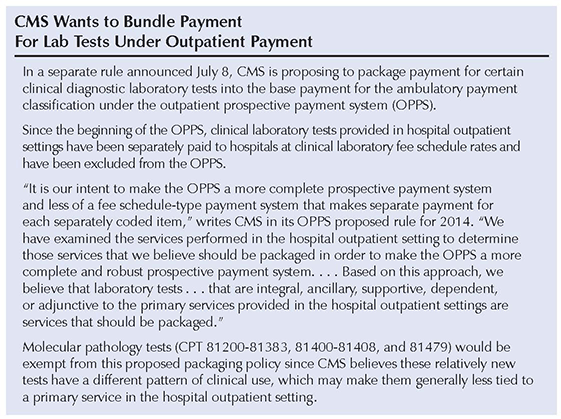If the ongoing Medicare payment cuts for clinical laboratory services weren’t enough, the Centers for Medicare and Medicaid Services (CMS) is now proposing to reduce payment under the clinical laboratory fee schedule to reflect technological changes.
The proposed physician fee schedule for 2014 will be published in the July 19 Federal Register. Comments will be due 60 days after publication.
In addition, CMS is also proposing to cut Medicare payment for pathology codes by 26 percent overall when services are provided by independent laboratories. These cuts are generally related to CMS’s proposal to cap the payments for certain nonfacility services at the facility rate plus the lower of the outpatient payment or ambulatory surgical center rate and its proposal to revise the Medicare Economic Index and adjust relative value units.
While the actual impact of these proposed cuts will depend on a lab’s test mix, the technical component of some tests may be cut by 50 percent to 70 percent, say sources.
CMS proposed the changes as part of its 2014 physician fee schedule proposed rule, announced July 8.
Adjustments for Technology
Under the clinical laboratory fee schedule (CLFS), once payment is established there is only one opportunity for CMS to reconsider the basis or amount of payment (within one year of when payment is set). Once the reconsideration process is complete, payment is not further adjusted except by a change in the consumer price index for urban areas (CPI-U), the productivity adjustment, and any other adjustments required by state.
In 2013, lab fees were cut by 4.95 percent due to a combination of reductions in the CPI-U, the productivity adjustment, the Patient Protection and Affordable Care Act, a 2 percent cut to help pay for this year’s Medicare physician fee fix, and the 2 percent across-the-board sequester. This year marked the third time in four years that the lab fee update has fallen into negative territory.
“This lack of an established mechanism to adjust payment amount is unique among the Medicare payment schedules and systems,” says CMS, noting that generally fee schedules are evaluated and adjusted each year to reflect the changing mix of services.
According to CMS, there has been a significant amount of technological change in the clinical laboratory area since the implementation of the CLFS, which has resulted in the increased use of point-of-care testing, brand new tests being developed, and the proliferation of laboratory-developed tests. These advances, says CMS, have made testing more efficient and automated.
“There are also brand new technologies that did not exist when the CLFS was established, most notably genetic and genomic tests,” writes CMS. “The cost of sequencing a genome has dropped dramatically since the early inception of this technology in 2001 from more than $95 million per genome to approximately $5,700 in early 2013.”
Five-Year Review
CMS is proposing a process under which it will systematically re-examine the payment amounts established under the CLFS to determine if changes in technology for the delivery of that service warrant an adjustment to the payment amount.
“We believe such adjustments could be made both to increase fee schedule amounts (for example, in situations where new high-cost technologies are employed), and to provide for reductions in existing amounts (for example in situations where technology reduces costs through increased efficiencies),” writes CMS. “We expect that most payment amounts will decrease due to the changes in technology that have occurred over the years since the payment amounts were established and the general downward trend of costs once technology has had an opportunity to diffuse.”
CMS proposes to begin reviewing codes that have been on the CLFS the longest and then work its way forward, over multiple years, until it has reviewed all of the codes. The agency says it will begin the review in 2015 and estimates it will take at least five years to review all of the existing codes.
The American Clinical Laboratory Association says it is deeply concerned with the proposals to cut lab and pathology payments, particularly since they come on the heels of a series of devastating cuts already experienced by clinical laboratories this year.
Despite clinical labs accounting for just 1.6 percent of annual Medicare spending, payments for lab services have been cut by more than 11 percent since 2010 and face double that amount over the next nine years.
